#and the plastic to make them is not recyclable
Explore tagged Tumblr posts
Text
Part 38 of is that French? 🐽🩹
(I spent forever on this one to not end up anywhere but with Damian’s pants down. It’s really bad haha)
Tim trudged into the bathroom. It was ten in the morning, there was far too much noise and commotion coming from in there, and he had a bag ready to throw over his boyfriend’s head to help him go back to sleep.
Just for a little bit. A few hours. Days. Weeks. He’d come back. He’s always talking about wanting to die again anyways.
As he shuffled past the threshold yawning with his heavy eyes closed, he raised the bag over his head and whipped it down creating a balloon. It caught and he felt that fight. Fell against his idiots back.
Tim: shh, shh. It’s ok. It’ll all be over soon. Then we can both go sweepy-
Jason: Tim?
Tim shot up. Kept his hands tight around whoever he’d caught as he stared at his husband who was sitting on their vanity’s counter. Jason had a face of horror.
Jason: we’re- were you going to suffocate me to sleep?
Tim, shrugging it off as he shook his head dismissively: huh, psh! No, of course not! I was sleep walking! …No? I was catching an intruder!
The person elbowed him. He grunted, released them and they whipped the bag off. He sneered at them then covered his mouth to hide the smirk as he realize he’d bagged Bruce.
Tim: I was practicing one of my new moves! What do you two think?
Jason narrowed his eyes on him. He was one hundred percent positive Tim had been trying to take him out but couldn’t prove it.
Jason: with a plastic bag?
Tim: yeah? Gothams riddled with them? It helps the recycling issue. Win-win.
Jason crossed his arms shaking his head.
Bruce:… I like it.
Jason tilted his head at Bruce in disbelief, his brows furrowed. Jason was generally the gullible one when it came to the family but when he was next to Bruce, he looked like a damn genius.
Jason: you do?
Bruce, rubbing his chin: I do. Using items we find on the street definitely it tactical.
Bruce tussled Tim’s hair as he began to leave. Tim blushed, his mouth forming this weird wiggling half smile half frown. Jason paused in confusion.
Bruce: very good Timmy. Always coming up with such good ideas. And not bad getting the better of me. Your skills are improving.
As he left and Tim lowered his head, Jason sighed. Why’d Tim have to be so cute when getting appraisal like that and worse, why’d it have to make Jason into a pervert and turn him on?
Tim: I was going to knock you out.
Jason: I know.
Tim: what were you two doing?
Jason: he’d taken all of my biore strips and bought me new ones.
Tim, sniffling: is that French?
Jason snorted as he reached out plucking Tim’s collar and dragging him in.
Jason: cmon, let’s give you a pampering.
Tim: I’m allergic to croissants.
Jason: no you’re not.
Bonus (if you are satisfied with the above don’t read because the below is pure crack)
Jason ran into Dicks room. It was a matter of seconds before he’d be caught up to. Dick, who was face timing Kon, waved his hands confused.
Dick: hello? I’m busy here.
Jason: busy being a bitch.
Dicks jaw dropped but he didn’t have time to respond as something small was tossed onto his bed. It was light, like paper, in fact it was paper, a corner torn off in a hurry. He heard a thud. His eyes lifted from it just in time to see Jason being dragged out the door, a shadow with glowing eyes dragging his legs.
Jason: make sure Damian gets to see it!
Eery silence pursued. Dick didn’t want to look. He didn’t want that fate. He stared down at that piece of paper on the corner of his bed. He didn’t want to look-
-
Dick: Damian!
Damian started, yanked his comforter up as Dick slammed his rooms door open.
Damian, blushing: knock!
Dick: there are no boundaries in this house Damian! If you want to do unholy things you’re better off in the Kent’s house! They might hear it but they’ll respect your privacy.
Damian: what the actual fuck! Get out!
Dick only neared further. Damian tucked into a ball. Dick tossed a small piece of paper on the bed. Damian clenched his jaw.
Damian: you did not come in here for this.
Dick: I did. I did break into your room catching you with your pants down for this. And Damian. It’s important. It’s so important. Give it to-
Dick fell to the floor with a thump. Damian didn’t even sit up as he heard nails scraping against the wood as he was being dragged out. He knew who had him and whatever the reason was he wanted no part of.
Except that piece of paper. Why was it so important?
Dammit.
Damian ducked down snatching it up. As he held it up he gave it a quick scan. It had three words. Tim was crying. Tim was crying? It sounded mean, but, Tim was crying? The man that made Clark Kent bawl over that hang in there cat poster because he told him the cat did, indeed, not hang in there? The man who sent Joker pissing in his pants because he’d taunted him playing Rebecca Blacks Friday on repeat for thirteen hours, that Tim?
Tim actually cried.
Bull.
What could possibly break a man like that? Who?
Fingers clasped around Damian’s ankles and in that moment he had one sole thought.
He really wished he’d pulled his pants up.
#tim drake#batman#jason todd#dick grayson#damian wayne#batfamily#Tim’s allergic to croissants#tim drake x jason todd#bruce wayne#clark kent#batman incorrect quotes#incorrect quotes#red robin#red hood#dc robin#nightwing#superman#joker#he did indeed not hang in there#Friday Friday fuck joker up on Friday
20 notes
·
View notes
Text
instagram
guys, wtf is this shit? are you kidding me?
NO.
put that away and leave it in the past.
first of all, where would you record your cassettes? do you want to buy a bulky stereo, turn on the radio and painfully wait for the song you want to record only to it to be cut by few seconds at the beginning and the end by the DJ talk?
do you want to directly buy official cassettes only for them to melt the first time you left them in your car (and lose the cover immediately btw).
or do you want to buy a bunch of CDs only to record them on cassettes? (because good luck in finding a pc with still a CD burner).
do you want to bring with you a bunch of them while traveling or just walking around because we are so used now to listen to very diverse music for a very long time? (you'll literally have to walk with a bag pack half filled with those to have the same variety)
do you want to experience the the "joy" of finding the magnetic tape all twisted by the gears or the slowing down of the music while your battery dies?
do you want to be constantly careful on how you handle the player because as soon as it get its first damage it's just downhill from there? (buttons and the door will be the firsts to go).
do you really want to incentive another useless exploitation of not recyclable plastic?
if you don't want to stream just get mp3. they're still an option you know?
now, mp3 players I'm all for it, go nuts.
#cassette players#are you seriously shitting me?#one thing is nostalgia another is stupidity#the magnetic tape will degrade in quality quite fast especially in warm weather#and the plastic to make them is not recyclable#who ideas it was?#put them to jail#Instagram
2 notes
·
View notes
Text

Accurately Draw Leigh Whannell's Jawline Challenge (difficulty level: impossible).
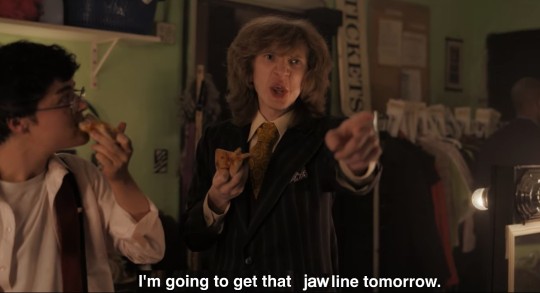
#saw 2004#saw art#leigh whannell#adam faulkner stanheight#sawposting#sketch#did I make things easier on myself by drawing this with a dying brush pen?#perhaps not#but I didn't want Jigsaw to put me in a pokey eyeball trap for throwing away a pen that still had a bit of ink left#'you have wastefully discarded your tools instead of cherishing them'#'now we will see if you can withstand my tools'#etc.#john kramer was really easily offended tbh#'you failed to correctly separate your recycling'#'now you must choose whether you will separate all of your limbs from your torso to survive'#'using only the plastic sword from this highlander funko pop'#if I was in a Jigsaw trap I would just immediately accept death because I hate following complicated instructions#my art
24 notes
·
View notes
Text
it really is true, i think, that no matter where you fall on a moral spectrum you'll be shocked at some things other people are willing to condone, and will seem sanctimonious to them if you disclose as much; and that in turn other people will be shocked at some things you're willing to condone, and will seem sanctimonious to you ditto…
for context this post is brought to you by my genuine (and unexpressed, ftr, except here!) startlement at seeing a blogger i've historically considered conscientious admit to not recycling their cat food cans
#and like. i know some people don't live in places that make recycling feasible for them.#i know plastics recycling is to a great extent a lie.#i know wet food is like. the grossest thing on earth.#but emotionally i just. can't help recoiling!#anyway i hate disclosing any of my personal stances bc i always immediately reflexively imagine strong counterarguments i respect#which leaves me just impotently going well. nonetheless‚ and probably unjustifiably‚ this remains the way i feel…#(as long as i'm disclosing Problematically Prescriptive Instincts: also p troubled by 'outdoor cats' [a delight to encounter… But Yikes]#and 'not wearing a bike helmet' [probably very fun! until. it abruptly isn't])#anyway. exercises in voicing opinions.
2 notes
·
View notes
Text
nvm i went on the plant milk person's blog and theyre too annoying for me to justify keeping their post rbed
#the kind of vegan who opposes the usage of wool (an easy resource to track the production of) and made some dumbass argument abt#dyes being bad for the planet therefore wool is just as bad as the million tons of plastic fabrics being made (even recycled plastic#nylon and polyester have a negative environmental impact. its almost like there are very few carbon neutral ways at all to make clothing.)#they didnt SAY anything in this line but they REMIND me of the girl i had to unfollow on insta who was like. honey is bee abuse but loved#tswift and vegan alternatives that abuse global south labor. like same vibe.#anyway luckily for me i can simply not talk to them#t
2 notes
·
View notes
Text
I watched a video by a guy who made a dupe of a very expensive all-plastic chair and had done one other video and he was like "guys i am NOT providing the file i do NOT want them to sue me"
and i thought that was pretty funny cause
1. as people pointed out in the comments the design was very easy to replicate in almost any 3D modeling program. The guy kind of struggled with it because he was new to 3D modeling (no shame! we all start somewhere) but... yeahhhh an experienced artist could make that fairly easily.
2. duplicating 3D models and providing the designs to people is what i do. (although tbf a very "fancy" business might be more s.l.a.p. happy than a business who stopped producing those molds ages ago)
3. although i support paying designers/artists well, there is something a touch... say, ironic... about selling something that is just an injection molded plastic lawn chair for $1200



#shutupotter#luxury goods#lmfao#also it doesnt look comfortable at all#granted it is made out of 25% recycled plastic so thats nice#unfortunately for them a bunch of other people#already make lawn chairs for much cheaper that are 100% recycled plastic#theyre still somewhat pricey like $200+ but at least they arent over a thousand
3 notes
·
View notes
Text
Is it infuriating my disabled, food-allergy having ass who doesn't live near a grocery store within walking distance on a good day has to order groceries from Amazon in order to survive? Yes. Do their new silver-foil insulation bags for frozen things mean I now have free wrapping paper for birthdays and holidays? Also yes
#frugal#not sure how i feel about those insulation bags they almost certainly aren't recyclable regardless of what the bag says#and i normally go for eco-friendly wrapping paper like just brown kraft paper or spam mail newspaper#but the foil insulation bags were going in the trash anyway so might as well give them one more use in life before that#sigh even if the bags were recyclable this apartment complex doesn't have recycling#also eco-friendly or not wrapping paper is such a scam#hell the eco-friendly wrapping paper should be cheaper because there's no foil or glitter or decor#but naturally the recyclable plain paper wrapping paper is 3x the cost of plastic coated wrapping paper#make it make sense#anyway PSA with the holidays coming up: most wrapping paper isn't recyclable so don't put it in the recycling bin#non-recyclable things in the recycling bin means the entire neighborhoods recycling gets thrown out#so all the recyclable things end up in the landfill regardless of intent
5 notes
·
View notes
Text
I went to New Jersey today and decided that I hate it there.
No plastic straws. Anywhere. Just paper straws that melt and feel horrible against my skin.
It's like the entire state hates autistic people. How the hell do you ban plastic straws?
#ik they're coastal and the litter affects the ocean and whatever#but how will mermaids do lines with no plastic straws?#jk but still#it's a sensory issue#it's also a paper pieces in my soda issue#fuck new jersey#new Jersey#paper straws#plastic straws#plastic#environmentalism#I'm sorry but you still gave me a plastic cup with a plastic lid and neither of those touch my lips make them paper or recycled#leave my straws alone#like I'd rather have a waxed paper cup and a recycled lid than a paper fucking straw#it's not even waxed or coated it's just awful
0 notes
Text
ADHDcore is clearing your bedside table at 1:30am after ??? months, including clearing half the OTC meds you own, a dozen candies you don’t like that are covered in dust, and like ten unopened pieces of mail
#tbf the mail is all stuff from SL#which aneki has absolved me of dealing with at present#sorry guys!!! you fucked up!! you gave money to a disabled person!!!#and not one of those cool go-getter ‘not gonna let it hold me back’ type of disabled people!#you are never getting that money back and eventually I will figure out how to legally tell you that!#but yeah I can’t just chuck them I have to recycle them#but you gotta rip out the plastic window first#and thus why they have been sitting. being garbage. on my bedside table. for months.#anyway I spritzed the table with my peony perfume#that I a d o r e but makes me dysphoric to wear#it smells like toys from my childhood 🥺
1 note
·
View note
Text
The wood is more natural and has a relationship with the ocean

#i feel like ive read about bacteria developing to consume plastic#pluuuuus our idea of synthetic is flimsy at best#like we 'make things' but like we dont - make them#i do love the idea of recycled#but like of more durable more frequently#available#like as in 'natural'#¿sabes?
55K notes
·
View notes
Text
Here's something that a lot of thin people don't know about being fat: you have to be very careful, these days, what the weight limit on your furniture is. So much is made of particleboard or even cardboard or flimsy plastic, and it may be great for the environment for things to be made of recycled materials, but it can easily leave fat people in the incredibly humiliating situation of breaking a chair by sitting on it, or a table by leaning on it. It also creates an effective "fat tax" on furniture, since the more solid materials tend to cost more.
When I was looking for loft beds to make my apartment effectively larger, the majority of them had a weight limit of 200 pounds, including the weight of the mattress. That puts a weight limit on the person of roughly 150 pounds, and that presumes a light mattress. That's not taking into account blankets, pillows, and stuffies, which can easily rack up a weight of around ten to twenty pounds without much trouble, bringing the safe weight for a person down to roughly 140 to 130 pounds. The ones that held more than that had a steep increase in price, with ones that held 300 pounds costing roughly 600$ more than the 200 pound ones, and the 400 pound ones, which I wanted for tolerances, ran a good 800$ more on average than the ones for 200 pounds.
More generally, solid wood, metal, tempered glass, and thick, durable plastic cost more than particleboard, cardboard, and flimsy plastic. They are also far more likely to be safe for fat people to use.
If you are a thin person and want fat people to be comfortable when visiting you, invest in furniture that is clearly made with sturdy materials. Having to brush off standing the whole visit is embarrassing both for us and, if you are a host who cares about the comfort of guests, for you.
16K notes
·
View notes
Note
I feel like if you're using a lot of disposable plastic bags in your day to day life, you've gotta do something sustainable to make up for it. Like using bamboo toilet paper or eco friendly cat litter or something, yknow
Honestly I exaggerate for comedic effect, while I DO routinely use ziplock bags to hold spaghetti I cook maybe once a month and the bag itself is usually for freezer storage. I actually throw out maybe one bag a week? I DO hate washing plates and tupperware and junk but that usually just means I eat sandwiches without a plate.
I agree though that needless waste should be avoided, and I do avoid it- biodegradable bags and recyclables, empty butter tubs used to store leftovers, etc.
This said, though, not applicable necessarily for myself but for a lot of others- I feel that it's importat to remember that there are many people who legitimately NEED things like plastic straws, or catheters, or pre-packaged foods
And the idea that that's a moral failing that individuals need to personally make up for when a single billionaire blows out more CO2 in a long weekend than I will in my whole life on a superjet meet-cute in the Bolivian rainforest between humvee drag races funded by the river-polluting textiles plants they planted in a third world country to avoid EPA laws and give an entire village stillbirths and stomach cancer is an idea that those very same bigwigs have spent a LOT of time and money investing in planting in the public psyche.
Like- Glass bottles are infinitely recyclable, so why are so many drinks in plastic now? Loads of drinks manufacturers used to buy them back and clean them for re-use, so why did they stop? If they chose to make something out of a limited and environmentally irresponsible material, why is it my failing to track down a correct process of disposal for them? What if there are none in my area? Do I lobby for more recycling plants in my area? Do I set aside some of my limited time outside the pain factory of my job- which I have more than one of, thanks to rising costs of things just like that drink I just emptied- to properly dispose of this company's waste FOR them?
Say coca-cola just rolled up to your town and started dumping millions of empty plastic bottles in the street, going, "wow, you should really think about building and staffing a recycling depot, it would be really shameful of you to just put these in the trash." When companies purposefully use materials with limited lifespans- because yes, even plastic can only be reused so many times- and tell you it's your own fault if it harms the environment- that's essentially what they're doing, just with more steps.
Yes, its important to be as environmentally concious as we can in our day to day life, but responsible sustainability is not catholicism. We don't get good boy points from our lord and savior Captain Planet every time the average low-income household gathers together to hold hands and repent for a single-use plastic that allows them to access something they need.
Entire families could eat trees and shit dead lithium batteries for years and still not do as much damage to the planet as an average dye plant or braindead celebrity does in a week just for fun, and I'm mad about it
...this went on longer than intended.
TL/DR: DO recycle and minimize waste, but don't beat yourself up over the little waste you can't avoid, and follow the money.
EDIT: Part 2
#I swear to god if any one of you in the notes calls me terminally online or pretends I'm saying you can just dump bags in the ocean#Yes definitely do your best to live sustainably#But also#You personally are not killing pandas#Unless you are in which case please stop#We put too much money into pandas but let them go in peace#Go do some yoga#Sorry if this is a lot but I have a friend with OCD who has legit panic attacks over stuff like this#Like they have to throw out a ripped plastic grocery bag they've had for six years instead of using it to weave yard furniture or smthn#And they'd go into a spiral about killing the planet#So like#I have strong feelings now
1K notes
·
View notes
Text

I Got about 5 yards of fabric twine in this ball and it’s smaller than a tennis ball. It’s a work in progress, I’m gonna make it as big as a basket ball. Stay tuned.
(Part 2)
#fabric#fabric twine#crafts#crafting#hand made#hand spun yarn#diy#craft in progress#my crafts#my projects#I’m thinking about making this into a woven basket to keep my fabric scraps in#I’ve got them all ziplock bags and plastic storage bins right now#stay tuned#fun craft#no waste#recycled
1 note
·
View note
Text
Okay!
So plastics! I took a deep dive into recycling HDPE plastics this winter because my seasonal job at the parks ended and because I knew there wasn't going to be much that I could do while I was recovering from surgery.
I'm going to talk about the process a little bit. Its not really a tutorial so much as it is just showing you the thing. The steps are uncomplicated, but they can be time consuming and there are MANY, with a high rate of failure. The good thing about the failure rate is that if you screw something up you can just melt it back down and try again.
I have been jokingly calling the processed material Amirite because once you melt it down enough times it looks like an agate. I made a separate blog about it: @adventures-in-amirite
But this process actually starts WAY back in June. As a parks person, one of our main annoyances is the amount of bottles (water, gatorade, powerade, PRIME, BodyArmor... whatever the Big American Energy Drink is right now) that get left overnight on weekends from people playing sports in our fields. 178 trash public trash cans in the city and they just leave them on the fucking ground.
When something unavoidable annoys me, I make it into a game. I learned that bottle caps are made from HDPE and LDPE plastics, which can be melted over and over again with household heating implements. So I started collecting them!
And I collected well over 300 caps over the summer. When I say it was a PROBLEM.
My seasonal job ended, which freed up a lot of time for me to experiment.
First thing I had to do was clean them.

Soak it in a mix of white vinegar and water or soap and water. Rinse, use a pressure setting on your faucet if you have one. Then let dry.
The next step is to sort all the caps into similar colors. After they're sorted, I melt all the similar colors together into a flat sheet using a panini press and parchment paper. My goal is to get the material thin enough to put it through a guitar pick punch. I like the shape of guitar picks.
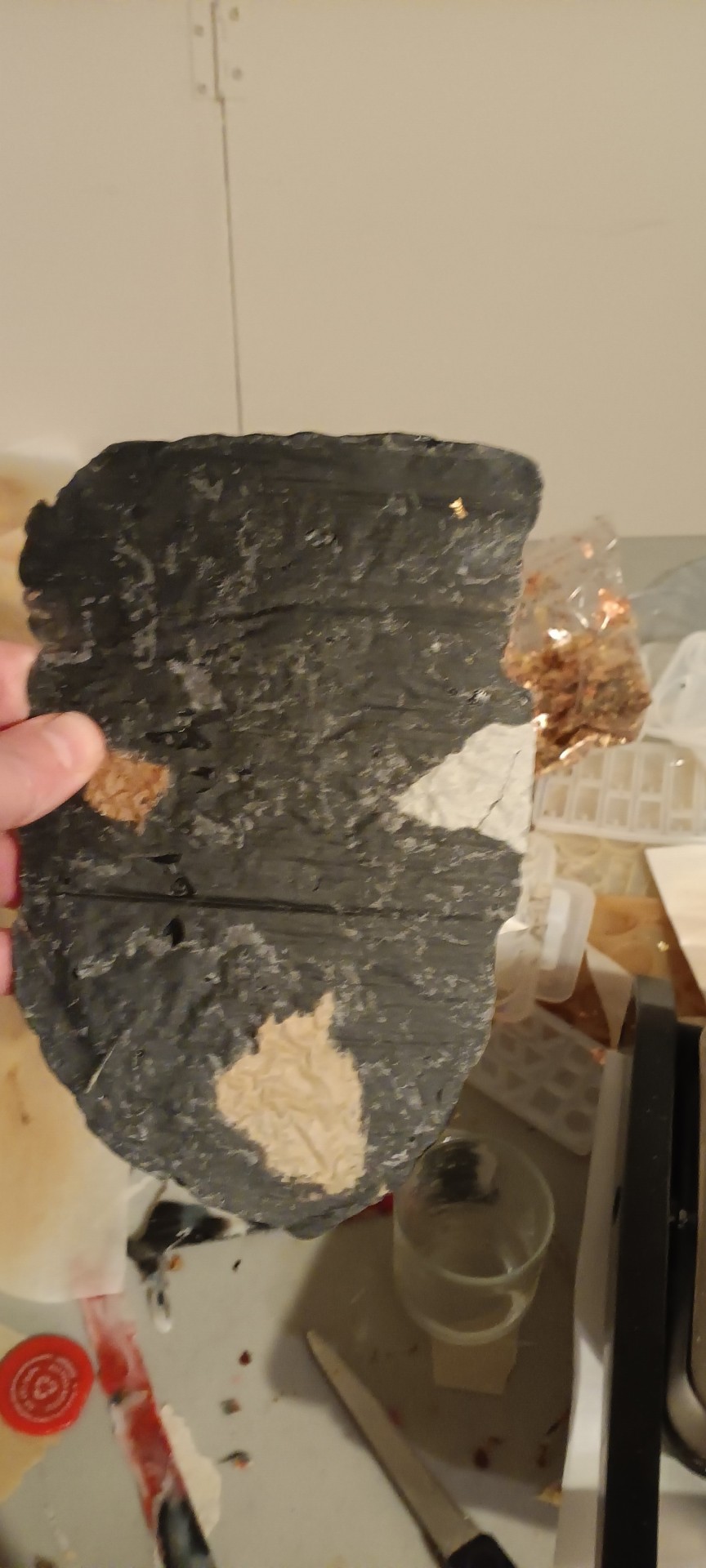

I am doing it this way because this means that I can have usable thin blanks of pure color.
Any scraps smaller than the guitar pick are cut up and sorted by color into 'frit,' which is a word I'm stealing from glassworking.
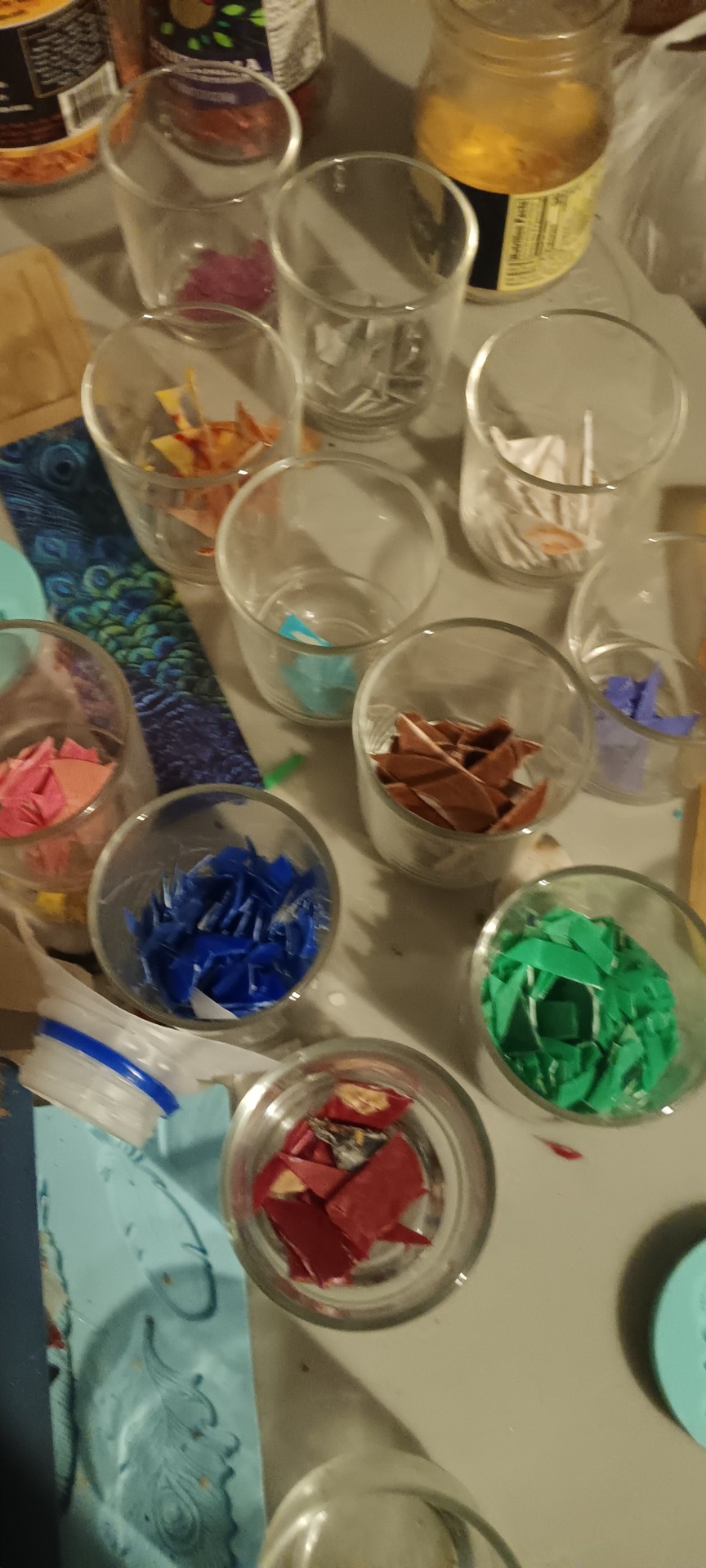
Now here is where it gets fun.
I pick some colors I want to work with in both frit and guitar pick blanks and I throw them on the press to melt them together into a big multicolored slab.
Let it cool.

Here's the high failure rate part.
I put down a silicone mold. I put the colored slab on top. I put parchment paper on top. I put it in the press. I let it melt.
I try to flatten it as much as possible to fit the mold. Use a bottle, a rolling pin, a spatula.
I still get bubbles and voids when I demold. I've decided to embrace that and use rub n buff to make fill the voids with metallic colors. Still working through the kinks in the process, but I think these look cool enough.

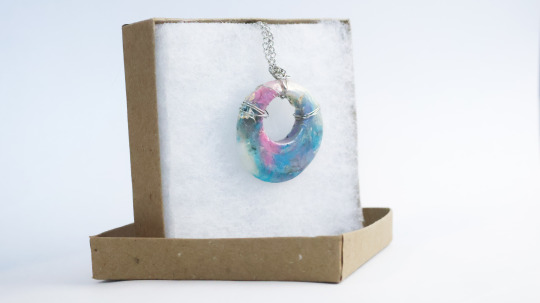
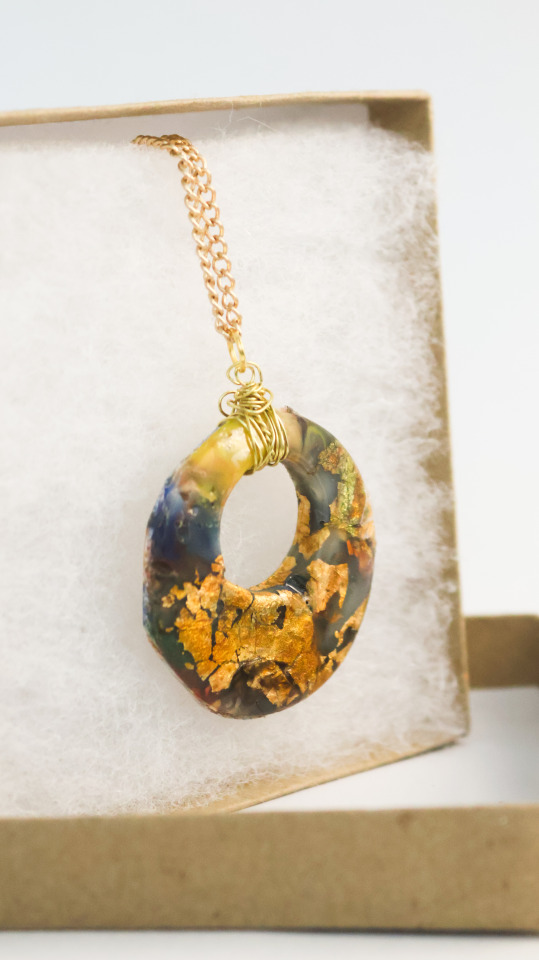
All the scraps go back into the bin to be re-processed. It makes a kind of agate texture that's really cool, and that's what I used in that last photo.
Anyways! Applications are limited but I'm having fun experimenting with it. Hoping to approach some shops about it and sell a few, maybe do some shows this summer.
Anyways, that's how my post-op has been going.
198 notes
·
View notes
Text
we gotta figure out the prescription bottle recycling thing man I get like 12 of them every month and it's an enormous amount of single use plastic that is going directly into landfills and the ocean. there's zero reason for pharmacies not to have empty bottle dropoffs, it's dry storage and easy to clean. one problem is plastic gets micro scratches and dings in it that make it difficult or impossible to sanitize to a medical standard, which would be solved by switching to glass bottles, but then glass causes transport problems with weight and fragility. I've researched this and the only way to recycle prescription bottles in my city is to, on your own, mail them somewhere that will do it for you. I think some of the privatized recycling services will do the same thing but I'm deeply suspicious of those services and suspect most of them are not actually recycling anything. the recycling infrastructure is so bad in the USA and the majority of our plastic recycling is not actually happening, it's just fake garbage sorting that ends up in landfills anyway. we HAVE to go back to using glass for everything, plastic recycling is a dead end.
2K notes
·
View notes
Text
Humanity's greatest achievement, the talking cookie jar, was callously discarded by a so-called "advancing civilization." I ask you now, are you happier now than you were when you had a cartoon dolphin in your kitchen? One that made an ear-piercing screech whenever you pulled its head open to retrieve a Famous Amos? It's time to get back to cookie jars.
Invented in 1491 by a rogue team of Chinese scientists who were looking for a place to safely store the cookies that they had invented the year before, the cookie jar promptly became a mainstay of every home. And then pretty much nothing happened for about another five hundred years, until talking cookie jar technology appeared.
It may seem hard to believe now, seated in the immeasurable comfort of modern-day technology like vtubers and even ztubers, but at the time, sticking a greeting-card noisemaker into a novelty piece of plastic was the only way to get a gift for your weird aunt that she wouldn't immediately smash on the floor and call your dad out for his many crimes against humanity. You had to be there, I guess.
Nowadays, scant few of these artifacts still remain, purged in humanity's rush to recycle old electronics. Perhaps there was also an element of fear around the unhealthy nature of leaving a baked good out in the bare air, tempting you to devour them whenever you entered the kitchen. Cookies themselves are as popular as ever, but we prefer to eat them directly from the package, in secret, away from the judgmental eyes of family members.
There is hope, however. With today's technology, cookie jars can once again talk. And not just that: they can feel. We've inserted a bio-synthetic machine sentience into every single one of these Garfield® cookie jars. It knows your schedule. It knows your diet. It passes judgment on you. And, critically, you are not allowed to recycle it under United Nations law, because we programmed it to feel pain. You can pick one up at your local K-Mart for sixty bucks plus tax. Makes a great gift for your weird aunt.
235 notes
·
View notes